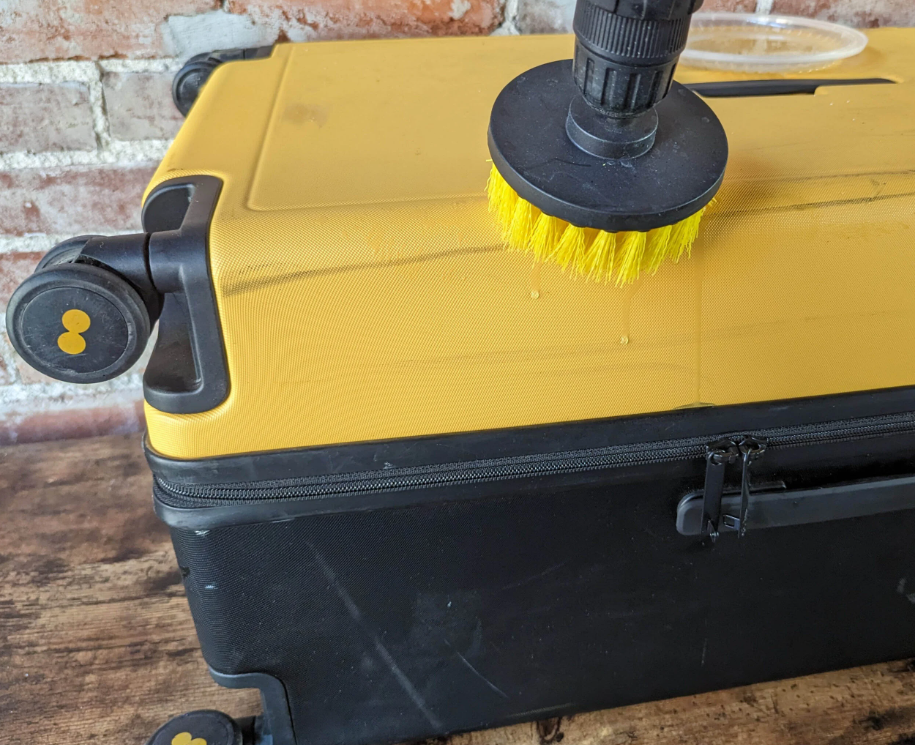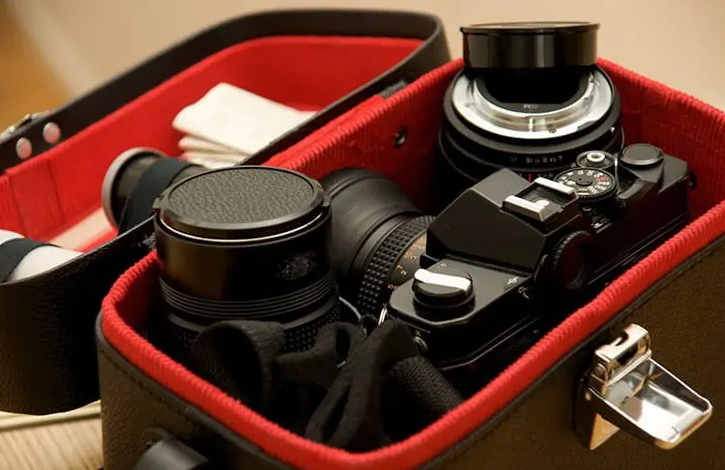To clean a hard shell case, empty it first, then identify its material. Use appropriate cleaning methods, followed by drying, reassembly, and proper storage.
Table of Contents
Types of Hard Shell Cases
Plastic Cases
Plastic cases are often the most economical choice and are widely used for various purposes. They are commonly made from materials like polypropylene or polycarbonate.
- Durability: These cases are generally durable enough for everyday use. However, they might not offer as much protection as metal cases.
- Weight: Being made of plastic, they are usually lighter, making them convenient for frequent travelers.
- Common Uses: You will often find plastic cases used for camera equipment, musical instruments, and other electronic devices.
- Cleaning: Due to their non-porous nature, cleaning is generally straightforward. However, they may be more prone to scratches.

Metal Cases
Metal cases offer higher levels of durability and are generally made from materials such as aluminum or stainless steel.
- Durability: These cases are extremely strong and can withstand higher levels of stress, making them ideal for protecting fragile items.
- Weight: Metal cases are heavier than their plastic counterparts. This increased weight can be a drawback for those on the go.
- Common Uses: These cases are commonly used for professional purposes, such as in medical equipment or audio-visual setups.
- Cleaning: Metal surfaces are easier to sanitize, but they are susceptible to corrosion if not properly treated.
Composite Material Cases
Composite material cases offer a blend of the benefits of plastic and metal cases. These are often made of a mixture of fibrous material and resin.
- Durability: Offering a middle-ground level of protection, these cases are sturdy but not as heavy as metal cases.
- Weight: These cases are lighter than metal cases but often heavier than plastic cases.
- Common Uses: Composite material cases find applications in specialized fields like aerospace and military equipment.
- Cleaning: They usually require specialized cleaning methods to maintain their structural integrity.
Preliminary Steps
Emptying the Case
The first task at hand is to empty the case entirely. Remove all items, dividers, or foam inserts that may be inside. This not only allows you to access all parts of the case but also prevents your belongings from getting damaged or wet during cleaning.
- Inventory: Take note of what’s inside the case before removing items. This helps when it’s time to put everything back.
- Check for Damaged Items: This is also an excellent time to inspect your stored items for damage.
- Common Items: Typical items found in hard shell cases can include camera lenses, medical equipment, or musical instruments.
Identifying Material Type
Knowing the type of material your hard shell case is made of will guide your cleaning methods. Is it a plastic, metal, or composite material case? Sometimes, the manufacturer’s tag or website provides this information.
- Consult Manufacturer Guidelines: Always look for guidelines provided by the manufacturer. They often include material specifications and cleaning recommendations.
- Visual Inspection: If the information is not readily available, a quick visual check or even tapping the case can give you clues about its material.
- Special Coatings: Be aware that some cases have a special surface coating that may require unique cleaning agents.
Gathering Cleaning Supplies
Once you’ve emptied your case and identified its material, gather the appropriate cleaning supplies.
- Basic Supplies: For most cases, a microfiber cloth, a soft brush, and mild detergent usually suffice.
- Specialized Cleaners: For metal cases, you might require specialized cleaning agents to avoid corrosion. Composite material cases might require unique cleaning solutions.
- Sanitizers: If you are keen on disinfecting the case, include disinfectant sprays or wipes in your cleaning kit.
General Cleaning Techniques
Dusting Off
Start with the basics—remove any loose dust or dirt from the case. Use a soft brush or a handheld vacuum to accomplish this.
- Soft Brushes: A soft-bristle brush works wonders in removing surface-level dust. Be sure to brush gently to avoid scratches.
- Handheld Vacuum: For a more thorough initial clean, a handheld vacuum can suck up even the smallest particles.
- Common Areas to Focus: Pay particular attention to corners, dividers, and small crevices where dust tends to accumulate.
Wiping with a Damp Cloth
Once you’ve removed loose dirt, a damp cloth can effectively clean most surfaces. Always use distilled water or a mild detergent mixed with water.
- Microfiber Cloth: A microfiber cloth works best for this, as it doesn’t leave lint behind.
- Damp, Not Wet: Ensure the cloth is damp and not soaking wet to avoid any moisture seeping into seams or sensitive areas.
- Sequence: Start from one end and work your way to the other to ensure you cover all areas.
- Rinse and Repeat: Rinse the cloth in clean water and repeat the process for particularly stubborn areas. This method is often used for laptop bags and cases.
Scrubbing for Stains
For persistent stains or marks, some scrubbing might be in order. Choose a scrubbing tool that is appropriate for your case material to avoid causing damage.
- Scrubbing Brushes: Choose a brush with soft bristles for delicate surfaces and stiffer bristles for more robust materials.
- Cleaning Agents: Some stains might require the help of specialized cleaning agents. Always spot-test a small area first.
- Elbow Grease: For stubborn stains, a little extra pressure may be needed, but exercise caution to avoid damaging the case.
Material-Specific Cleaning Methods
Cleaning Plastic Cases
Plastic cases are generally easier to clean, but you should still use the right techniques to prevent scratching or warping.
- Mild Detergent: A mixture of warm water and mild dish soap works well for plastic cases.
- Non-Abrasive Sponge: Use a sponge or soft cloth to apply the mixture, gently scrubbing the surface.
- Rinse and Wipe: After scrubbing, rinse the case with clean water and wipe it dry with a microfiber cloth.
- Special Care: Plastic cases often come in various colors, so be cautious when using cleaning agents to prevent discoloration.
- Extra Tip: For tougher stains, consider using baking soda as a natural abrasive cleaner. This is often recommended for children’s toy storage cases.
Cleaning Metal Cases
Metal cases, while more robust, need careful handling to avoid issues like corrosion or oxidation.
- pH-Neutral Cleaner: For metal cases, particularly aluminum ones, use a pH-neutral cleaner to avoid corroding the material.
- Soft Cloth: Apply the cleaner using a soft cloth, avoiding the use of any abrasive scrubbers that can scratch the surface.
- Buffing: Once you have thoroughly cleaned the case, you can opt to buff it using specialized metal polishes.
- Avoid Water Accumulation: Ensure that you dry all crevices and seams thoroughly to avoid water accumulation, which can lead to rust.
- Special Note: Metal cases used for storing musical instruments often have velvet or felt lining, which require different cleaning techniques.

Cleaning Composite Material Cases
Composite material cases are a hybrid, blending the features of both plastic and metal. They often require more specialized care.
- Spot Test: As these cases can be sensitive, always perform a spot test with any cleaner you intend to use.
- Manufacturer’s Guidelines: Most of the time, these cases come with a set of specific cleaning instructions. Make sure to follow them.
- Gentle Approach: Use a soft cloth and mild cleaner, similar to those you would use for a plastic case.
- Focus on Seams: The blend of materials can make the seams of these cases particularly susceptible to dirt accumulation or damage.
- Special Cases: These types of cases are often used for specialized purposes, like aerospace or military, and may have specific maintenance needs.
Internal Cleaning
Vacuuming the Interior
Before you get down to washing or wiping the inside, vacuuming can remove loose debris, dust, and other particles from the case’s interior.
- Handheld Vacuum: Use a handheld vacuum to get into all the corners and niches. Make sure you use an attachment that’s free of any sharp edges to avoid tearing the internal lining.
- Brush Attachments: If your vacuum comes with brush attachments, use them for better cleaning. This is particularly useful if the case has foam inserts.
- Hard-to-Reach Areas: Pay attention to hard-to-reach spots like seams and pockets. These areas often collect more dirt and debris.
- Important Note: Make sure to unplug any integrated electronic components before vacuuming.
Dealing with Odors
Over time, cases can develop unpleasant odors due to moisture, mold, or the items stored inside.
- Baking Soda: A natural deodorizer, sprinkle some baking soda on the case’s internal surfaces and let it sit for a few hours before vacuuming it up.
- Charcoal: You can also place activated charcoal inside the case to absorb odors. Make sure to remove it before using the case again.
- Ventilation: Sometimes, all a case needs is some good old-fashioned fresh air. Open the case and let it air out in a well-ventilated area.
- Avoid Perfumes: It’s not advisable to spray perfumes or air fresheners directly into the case as they can damage certain materials or stored items like musical instruments.
Spot Cleaning the Lining
If your case has a fabric or foam lining, spot cleaning is an effective way to deal with localized stains.
- Mild Detergent: Use a cloth or sponge dampened with a mixture of water and mild detergent. Gently dab on the stained areas.
- Rinse and Dry: Use a clean, damp cloth to rinse off the detergent. Make sure you thoroughly dry the area afterward to prevent moisture buildup.
- Special Cases: Some cases might have specialized linings for soundproofing or insulation, so check any care instructions provided by the manufacturer.
Sanitization Methods
Using Disinfectant Wipes
Disinfectant wipes offer a convenient and quick way to sanitize surfaces.
- Choosing the Right Wipes: Go for wipes that contain at least 60% alcohol for effective sanitization. Some are specifically formulated for different materials.
- Wiping Technique: Use firm, even strokes to wipe down all internal and external surfaces of the case.
- Drying Time: Allow the case to air-dry after wiping it down. This is important as the disinfectant needs some time to kill germs effectively.
- Safety Note: Always read the instructions on the product. Some wipes are not suitable for certain materials like leather or fabric commonly found in camera cases.

Spraying with Sanitizers
Sanitizing sprays offer another effective option, especially for hard-to-reach areas.
- Spray Types: Choose a spray that is compatible with the material of your case. Alcohol-based sprays work well for most materials.
- Application: Hold the spray bottle about six inches away from the surface and spray evenly.
- Ventilation: Make sure to do this in a well-ventilated area and allow the case to dry thoroughly.
- Additional Step: For extra precaution, you can wipe the case down with a clean cloth after spraying.
Natural Alternatives for Sanitization
For those who prefer a more natural approach, there are eco-friendly options.
- Vinegar Solution: A 50/50 mixture of water and white vinegar can act as a natural disinfectant. Note that vinegar may not be suitable for all materials.
- Tea Tree Oil: A few drops of tea tree oil in water can be an effective natural sanitizer. However, its strong smell may not be to everyone’s liking.
- Sunlight: Simply placing the case in direct sunlight for a few hours can help kill some types of bacteria and viruses. This is an age-old method often used for textile sanitization.
Drying the Case
Air-Drying Method
Air-drying is the simplest, yet often the most effective, method for ensuring your case is thoroughly dry.
- Open and Place: Open the case and place it in a well-ventilated area. Make sure it’s oriented in a way that allows for the maximum air circulation inside the case.
- Remove Inserts: If your case has removable inserts or compartments, take them out to speed up the drying process.
- Check Corners: Pay special attention to corners and seams, as water tends to collect in these areas.
- Extra Measure: If you want to speed up the air-drying process, consider using a fan. Just ensure it’s not too close to the case, as excessive wind can attract dust particles.
Using Towels
Using towels is another effective way to speed up the drying process, particularly for cases with absorbent internal linings.
- Absorbent Towels: Opt for microfiber towels, which have higher absorbency compared to regular cotton towels.
- Blotting Technique: Gently blot the internal lining and external surfaces with the towel to absorb excess moisture.
- Replace Towels: If one towel becomes saturated, replace it with a fresh, dry one to continue the drying process.
Considerations for Humid Environments
If you’re in a humid environment, drying your case requires extra attention.
- Desiccant Packs: Use desiccant packs to absorb moisture. These are especially useful for electronics cases that require a dry environment.
- Indoor Air Conditioning: Utilize indoor air conditioning to reduce humidity and speed up the drying process.
- Avoid Direct Sunlight: In humid climates, excessive heat can actually increase the moisture level inside the case. It’s best to dry it in a shaded, well-ventilated area.

Reassembly and Storage
Reinserting Padding or Dividers
Many hard shell cases come with removable padding or dividers, especially those designed for specialized equipment like cameras or musical instruments.
- Check Dryness: Before reinserting any padding or dividers, make sure they are completely dry to avoid moisture buildup.
- Alignment: Carefully align the padding or dividers as they were before removal. Incorrect reassembly can result in poor fit for your stored items.
- Secure Attachments: If the padding or dividers have Velcro or other fasteners, ensure they are securely attached to prevent movement.
Storing the Case Properly
Proper storage is crucial for maintaining the long-term quality of your hard shell case.
- Cool and Dry Location: Store your case in a cool, dry area to prevent moisture accumulation or warping of the materials.
- Avoid Stacking: If possible, avoid stacking other items on top of the case as this can deform its shape over time.
- Long-Term Storage: For long-term storage, consider adding desiccant packets inside the case to absorb any residual moisture.
- Check Regularly: If you won’t be using the case for an extended period, it’s a good idea to check its condition periodically for any signs of moisture or damage.
Maintenance Tips
Regular Check-ups
Just like any piece of equipment, a hard shell case benefits from regular check-ups.
- Visual Inspection: Periodically look over your case for signs of wear and tear, such as scratches, dents, or loose parts.
- Functional Test: Zip and unzip, lock and unlock, and open and close the case several times to ensure all mechanisms are working smoothly.
- Clean Periodically: Depending on usage, clean the case once every few months or more frequently if it is exposed to harsh conditions. This keeps it looking and smelling fresh.
What to Avoid
Certain actions and environments can drastically reduce the lifespan of your case.
- Extreme Temperatures: Avoid storing your case in places with extreme temperatures, hot or cold, as this can cause material to warp or degrade.
- Chemical Exposure: Be cautious of using harsh chemicals for cleaning, as they can strip the protective coating off some materials.
- Overloading: Overloading the case can strain the zippers and locks, leading to premature wear. Check the manufacturer’s weight guidelines before packing.
Recommended Products for Cleaning
The right cleaning products can make your maintenance routine more effective.
- Microfiber Cloths: Ideal for cleaning and drying almost any material without leaving scratches or lint.
- Gentle Detergents: Opt for pH-neutral cleaning agents for wiping down the case.
- Alcohol Wipes: Great for sanitization, but ensure they are compatible with your case material.
- Desiccant Packs: These are excellent for absorbing moisture, especially if your case stores sensitive equipment like cameras or medical instruments.






